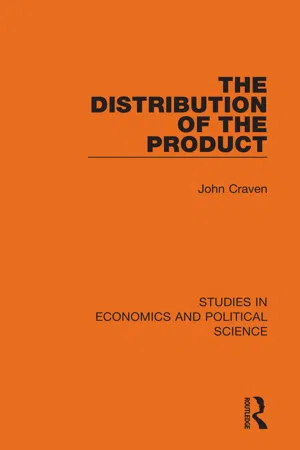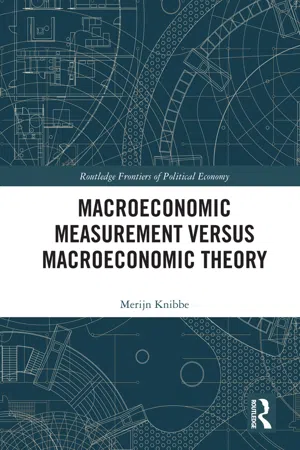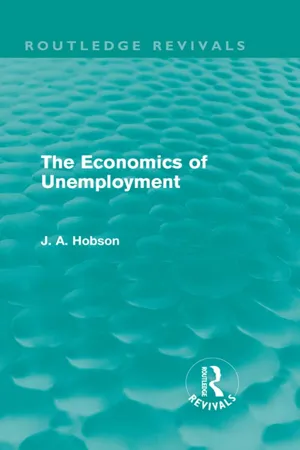Consumption and Savings
Consumption refers to the use of goods and services by households, while savings is the portion of income that is not spent on consumption. In economics, consumption and savings are key components of the circular flow of income and are influenced by factors such as income levels, interest rates, and consumer confidence. These two concepts play a crucial role in understanding and analyzing an economy's overall performance.
6 Key excerpts on "Consumption and Savings"
- eBook - ePub
Foundations of Macroeconomics
Its Theory and Policy
- Frederick S. Brooman(Author)
- 2017(Publication Date)
- Routledge(Publisher)
...So everything depends upon the way in which the various categories of spenders react to changes in their incomes; it is a matter of such importance that several subsequent chapters will be devoted to exploring the connection between income and demand. Meanwhile, however, some further points must be made regarding the nature of the equilibrium of the economy as it has so far been outlined. 3. The Saving-Investment Relationship The first of these points concerns saving, which has not so far been mentioned and which may be defined in a general way as the part of disposable income that is not spent on consumption. In the case of individuals, this seems a fairly straightforward concept. 12 Whatever is left of a man’s income after he has paid his taxes will be available to him for outlay in various ways. He may spend it on commodities that he consumes – in which case nothing will be left behind as wealth to be carried over into the future – or he may use it in some other way that will leave him better off. He need not accumulate cash, of course; he may buy government bonds or common stock; he may acquire a house; if he is the owner of a small business, he may use part of his income to increase its equipment or its inventory. Saving is thus not the opposite of spending, but merely the alternative to the spending of income on consumption. Consumption and saving together will account for the whole of the individual’s disposable income. For the nation as a whole, the definition of saving is slightly more complicated. It would not be correct to subtract consumers’ expenditure from National Income and call the remainder “saving,” because no allowance is made for the “collective consumption” represented by government expenditure on goods and services...
- eBook - ePub
- Anthony J. Makin(Author)
- 2016(Publication Date)
- Routledge(Publisher)
...Conversely, the broader measure reflects total consumption possibilities available to the economy. A second measurement issue relates to conventional saving being understated, owing to national accounting convention treating all public expenditure on education and health as consumption. Yet part of this spending may alternatively be perceived as investment in, and preservation of, human capital. If re-classified as such, public consumption would be lower, and public and national saving higher. This should be taken into account when making international comparisons of saving rates, as governments in advanced economies tend to spend proportionately more on education and health. Hence, other things equal, saving in advanced economies will be lower than in developing and emerging economies, which spend relatively less in these areas. Many advanced economies experienced declines in national saving over recent decades, as conventionally measured. During recessions, public saving falls as a result of higher welfare spending and lower tax revenue, while private saving also falls as households sustain private consumption though having lower income, consistent with the permanent income theory of consumption. Within private saving there are two sub-components – household saving and corporate or business saving. The household saving component of private saving declined over recent decades in advanced economies after substantial financial liberalisation. Interestingly, however, falls in household saving were often offset by rises in business saving, leaving gross private saving largely unchanged. A reason for this is that corporate saving reflects the retained earnings of incorporated enterprises, so when the profit share rises, corporate saving rises, but this also implies a corresponding fall in the wage share, which acts to reduce household saving. Moreover, the amount of corporate saving reflects companies’ dividend policy...
- eBook - ePub
- John Craven(Author)
- 2021(Publication Date)
- Routledge(Publisher)
...For example, a young man may borrow to finance his education or to buy a home, pay back these borrowings in middle age and at the same time save to provide for his retirement or to educate his children. Once again saving and borrowing depend on his view of the interest rate that he will receive on his accumulated assets or that he will have to pay on his debts. Once again a change in the interest rate is likely to affect the proportion of his income that he saves (which may be negative if he borrows or consumes out of capital), exactly as in the two-dimensional example of Figure 22. A microeconomic theory of this kind is made more complicated by recognising that consumption in any week consists of demands for various goods. Saving behaviour is then influenced by expectations of future changes in the relative prices of the goods that an individual wishes to consume. For example, if food prices are expected to rise relative to those of some luxury goods, a man may wish to save more by reducing his current consumption of luxuries to avoid future starvation. A full theory of this kind must therefore take account of the individual’s expectations of changes in relative prices, and we must, in general, consider the price of and demand for every good in every week. If he expects to live for 1,000 weeks and consumes twelve different goods, we shall have a problem with 12,000 dimensions. Furthermore, the theory only deals with one consumer at a time, and there may be many to consider, each with different preferences and different expectations of future price changes. 5.2 Savings Propensities The life cycle theory of savings is attractive at the microeconomic level, but it is not much use in an attempt to construct a simplified macroeconomic theory of distribution. We need some sort of approximation to the way in which individual decisions to save and borrow will balance out to give an overall view of the role of savings...
- Merijn Knibbe(Author)
- 2019(Publication Date)
- Routledge(Publisher)
...Also, modelers and statisticians alike seem to agree about the dictum of Adam Smith: ‘ consumption is the sole end and purpose of all production’. But in most DSGE models public goods and services and durable goods are excluded. And there are more differences between the statistics and the models. The national accounts have a well-articulated, granular and estimated definition of consumption. The models have an implicit and fuzzy ‘one good’ concept of consumption. Also, ‘household consumption’ as defined by the national accounts can, as far as it constitutes the purchase of market goods, be considered to be the transaction which transfers goods and services from the monetary economy to the non-monetary realm of home, household and family – a sphere absent from the models. The crossing of this border is less clear for public goods and services, which include items like defense and education which are not directly used in the household. These items are part of the monetary economy. How does this all come together? How do statisticians operationalize and measure it and how do the modelers look at this? These questions are central to the next paragraphs. 6.2. Consumption in the national accounts: definitions and operationalizations The national accounts define consumption as: ‘ final consumption expenditure consists of expenditure incurred by resident institutional units on goods or services that are used for the direct satisfaction of individual needs or wants or the collective needs of members of the community ’ (ESA 2010 lemma 3.94). This community can be the residents of a country, even when consumption of people on vacation abroad count as an export of the destination country and consumption of country of origin. When people are permanent residents of another country, their consumption is supposed to be part of the consumption of the host country. The community can however also be members of a church or a sports club. Consumption is all about expenditure...
- eBook - ePub
Economics After the Crisis
An Introduction to Economics from a Pluralist and Global Perspective
- Irene van Staveren(Author)
- 2014(Publication Date)
- Routledge(Publisher)
...So, although the propensities to consume decline with rising income, the absolute amounts spent on consumption will generally not go down. This is because consumers with higher incomes tend to shift to the more luxury segments of a product category. For food, this means prepared food from the supermarket, exotic food from the delicatessen shop, and eating out in restaurants. Diagram 3.2 Engel curve The propensity to consume (c) can be written in the following equation as the share of income (Y) going to consumption (C): C = cY The propensity to save (s) is its complement, namely the proportion of income saved (S): S = sY Together, income is distributed over Consumption and Savings: Y = C + S In other words: y = cY + sY So, if income is 1,000 roubles and the propensity to consume is 0.8, then total consumption is 0.8 × 1,000 = 800 roubles. And, because Y = C + S, we can derive that total savings is 200 roubles, which is Y − C. This is 1,000 − 800 = 200. Finally, it follows that the propensity to save is 0.2, because S = sY, so 200 = 0.2 × 1,000. And also because the sum of the propensity to consume and the propensity to save is 1 (if we disregard borrowing, using the ceteris paribus assumption): c + s = 1 Hence, if c = 0.8 and c + s = 1, then it follows that s = 1 − 0.8 = 0.2. 3.5 Neoclassical theory of consumption 3.5.1 Individual and market demand In a purely material way, demand for a particular consumer good depends on its price level and the available budget. We tend to buy more of a good when it is cheap and when we have more income, and less of a good when it is expensive and when we have less income. This is the case for normal goods, the standard case in neoclassical economics. This results in a negative relationship between price (P) and quantity (Q), as Diagram 3.3 shows. When prices are high, quantities demanded are low, and the other way around. The result is a straight downward sloping demand curve (D 1) for, say, healthy meals bought per month...
- J. A. Hobson(Author)
- 2013(Publication Date)
- Routledge(Publisher)
...It is put either into durable commodities, such as houses, furniture, better clothing, and other personal utilities, or else into better education for themselves and their children, travel and recreation and other expenditure which upon the whole makes for higher personal and economic efficiency. In short, a larger proportion of their saving goes into personal as distinct from investment capital, than is the case with the saving of the rich. This application is probably far more productive in the long run than any small additions which these savings might otherwise have made to the volume of invested capital. (3) Such investments as they make are mostly confined to provision against critical emergencies in the family economy, the cost of burial, sickness, disablement, old age, or unemployment. Even here few workers could by any thrift make a sufficient provision against prolonged disablement, not to speak of adequate provision for surviving dependents. Saving, in order to live more expensively later on, or to make a considerable provision for the family after death, which are the chief incentives to the saving of the well-to-do, do not yet belong to working-class economy. (4) Such saving as they make even for short-range emergencies, much more for distant ones, is costly, not only subjectively, in that it involves a sacrifice of really useful and highly valued present satisfaction. It is also objectively costly in two ways. Such small savings are seldom able to find advantageous investments, their cost of collection and administration in Friendly Societies and similar organisations is very large, so that they may be said to rank very low in the investment market. Still more deterrent against such saving is the high measure of uncertainty in the power to keep up payments of premiums or other contributions...





